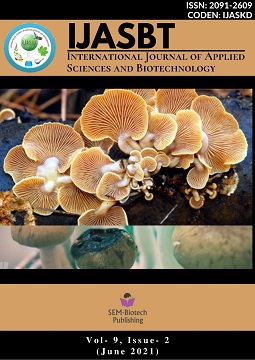Crop Protection Practices in Traditional Agriculture in mid-hills of Western Nepal: A Case of Palpa and Gulmi District
DOI:
https://doi.org/10.3126/ijasbt.v9i2.36305Keywords:
Disease, horticulture, indigenous knowledge, Nepal, traditional methodsAbstract
A field survey was conducted in two districts of western hills of Nepal during July-August, 2020 to study about the practices of traditional methods of horticultural crop disease management. A total of 125 farmers, 10 traders, 5 agro-vets, and 3 plant clinical doctors from four local bodies of two districts; Palpa and Gulmi, were selected for the interviews which employed a pretested questionnaire. Descriptive statistics were used to analyze the data. Almost half of the farmers interviewed (48%) were found to have an average level of knowledge regarding the application of indigenous methods. Mixture of kerosene and ash, mugwort solution, plant residues, bovine dung and urine, chilli powder, papaya leaves, onion mixed with garlic, etc. were popular as traditional techniques to effective control of disease and pest. Scaling technique used in this study showed the lack of indigenous information as the most serious constraint in adoption of traditional means, followed by lack of advertisement, poor social perception of farmers, and weak cooperation among social and agricultural scientists. The study recommended that documentation and scientific validation of indigenous means and support from government and extension agents are necessary to encourage farmers using traditional means. This study examines traditional diseases/pests control strategies implemented by the ancients and presently adopted in ongoing practices.
Int. J. Appl. Sci. Biotechnol. Vol 9(2): 138-151.
Downloads
732
531




